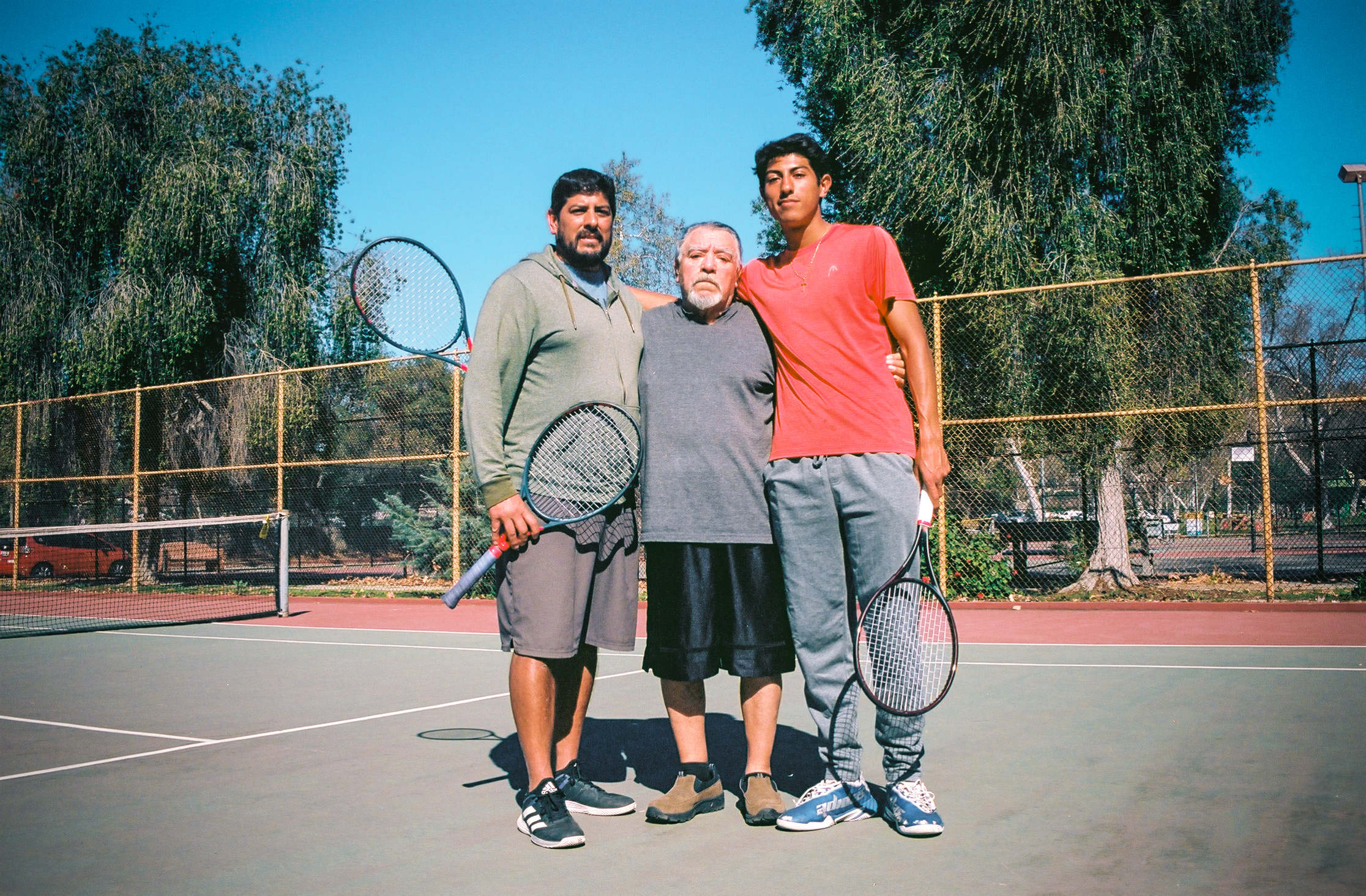Die-hard Chicano tennis players have been hitting balls at the Hermon Tennis Courts for nearly 50 years. It’s a community of self-taught, mostly retired men and women who come from nearby Lincoln Heights and Cypress Park and as far as Whittier and Simi Valley to play in what they call the Arroyo Seco Tennis Club for the camaraderie and competition. In the white-dominated world of tennis, they’ve carved out a space for themselves and are so passionate about the sport, they’ve unlocked the secret to long life: stay active and socialize.
“When we all worked, we used to play from five until they kicked us out,” said Guillermo Reyes, 72, a retired probation officer who formed the tennis club back in 1976. “They’d say, ‘Hey you guys gotta leave’ and we’d go move our cars, then come back and play till 11. I’ve been retired for 14 years now so by four o’clock, I’m done [laughs].”
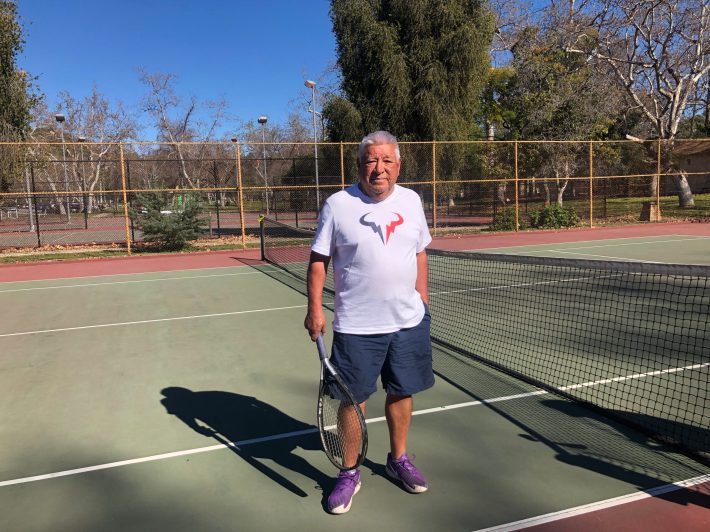
Reyes’ family has deep roots in L.A. They’ve been here for five generations and were displaced from their home in East L.A. back in 1955 when the 710 freeway was built and tore apart Black and Brown communities. He sports white hair and skin the color of clay courts. He has the energy and social circle of an outgoing 20-something and is active in his Cypress Park neighborhood, where his family relocated. He started a Senior Center there and helped stop development in what is now Rio de Los Angeles State Park and the L.A. River Center.
He used to live in an apartment right across the street from the Hermon Tennis Courts but credits a bailiff at the Eastlake Juvenile Courthouse in Boyle Heights, where he worked for 40 years, for turning him on to the sport. The bailiff introduced him to his brother-in-law, Richard Lopez, who lived nearby and was fiending to play. Lopez brought friends from the Eastside, including Garfield, Rosevelt, and Salesian High School and Reyes brought friends from Lincoln and Cathedral.
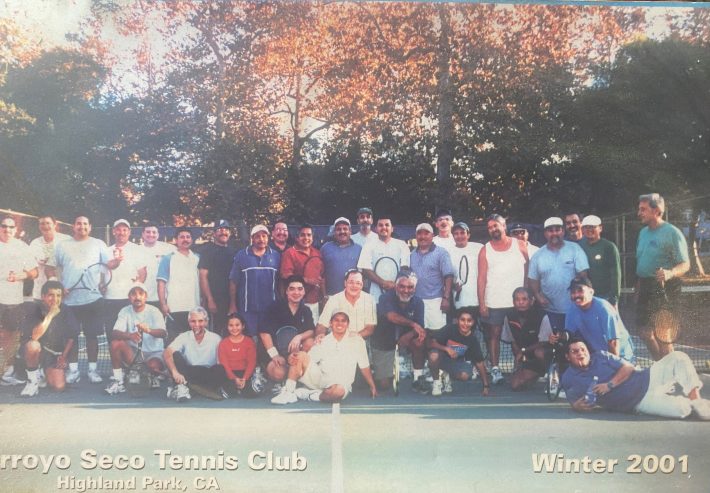
“When I first met my ex-wife, I used to pick her up from Franklin [High School] and drive by the courts and say, ‘Look at all these nerds playing tennis,’” Reyes said. “We’d park in the back and fool around.”
Ironically, he formed a tennis club that at its height had 60 players and today has about 45, including women like Tina Karwasky, the Glendale-born Japanese American former tennis pro who coached Cal State L.A. women’s tennis for 21 seasons and Dee Williams-Horne, a Black woman who plays in United States Tennis Association (USTA) tournaments. They play here four times a week and have monthly potlucks on the grass outside the courts. John Espinoza, a retired LAUSD elementary school teacher, brings his fire pit and they gather around a bonfire at sunset. Everyone pitches in to cover the cost of food, beer, and tequila. For Reyes’ birthday, they had mariachis and a taquero.
“I usually roast a turkey and Andy brings the ham,” said Reyes, who wants to rename the courts Bobby Riggs after the Lincoln Heights-born, Franklin High School graduate and former number one men’s player who lost to Billie Jean King after retirement in the famous “Battle of the Sexes'' tennis match.
Tucked inside the Arroyo Seco between the 110 freeway and Monterey Road, these 11 tennis courts are surrounded by Sycamore trees and bumpy, gopher-infested grass. A newer, lime green playground sits in the middle with a dog park at the northernmost corner. A bike path once strewn with homeless encampments runs parallel to the Tiny Home Village, where some of the unhoused were recently relocated. Coyotes occasionally pop in to keep everyone on their toes. Hermon is a historically working-class neighborhood, but being a stone’s throw away from Highland Park (they share the same zip code), it’s been ground zero for gentrification. What was once a hangout for the Avenues gang, is now a gathering place for families, people walking dogs, and outdoor exercisers.
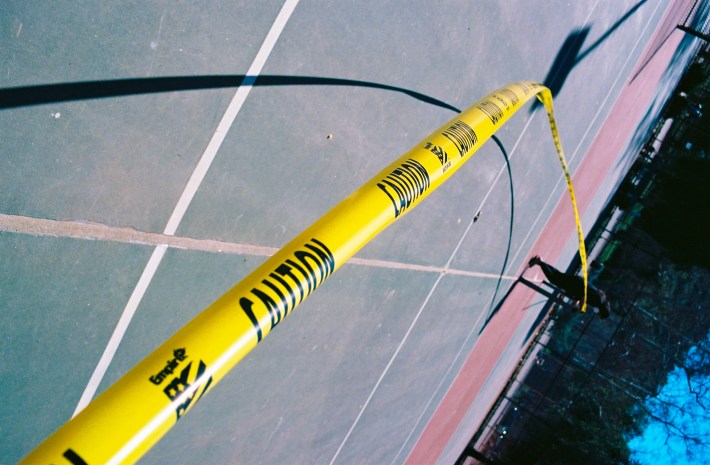
“Gentrification has tripled the amount of cars at the park,” said Andy Cota, 72, another O.G. and Vietnam vet who considers tennis therapy. “I couldn’t even find parking the other day.”
Though the demographic has changed, the courts haven’t. They’ve been in disrepair for 20 years. Surfaces are filled with cracks, trash cans are tagged up and nets were at one point held together with duct tape. One player injured his hand on a broken, rusty fence. Regulars have begged the city for years to fix them. A banner went up last year announcing a renovation, then signs asking for patience with material delays and shortages. A call to Kevin De Leon’s office revealed the first contractor was fired for making mistakes and Recreation & Parks estimates an April 2022 completion date as new fences and nets have finally started to spring up. Some folks got frustrated and started playing at courts in South Pasadena and Arcadia.
“When I first started playing here, there were like 100 people,” said Victor Aguilera, who’s been a regular for 40 years. “But as the courts got worse, less people played.”
Back in the day, Hermon Park was the lawn bowling capital of the world. After the Arroyo Seco Lawn Bowling Club was built in 1937, people flocked here from all over to play at what was the only park on the planet with four bowling greens. Lawn bowling was replaced by tennis and in its heyday, you could get your racket strung inside an actual clubhouse. Pancho González, the most famous professional Chicano tennis player who turned pro in 1949 and served 114 m.p.h. with a wooden racket, is rumored to have played here.
Today, Julio Cesar “J.C.” Vargas, Jr., 22, is Hermon’s Golden Boy. He’s been playing tennis since he was five and was introduced to the sport by his father, Julio Vargas, who was introduced by his father, Guillermo Mata Moreno. All three play at the Hermon Tennis Courts. Born in Mexico City, Moreno immigrated to L.A. in his 20s and started playing tennis at Lincoln Park. When the courts got too crowded, he discovered Hermon and at one time played here every day from morning to late afternoon.
Standing 6’ 2” and sporting a tennis tan and gold chain, J.C. is the only player here who isn’t self-taught. He was coached from the age of 13 to 18; at one point by John Letts, a former pro who owns the iTennis franchise, a high-end tennis program that contracts with local cities, including South Pasadena and West Hollywood, to provide private and group lessons, tournaments, leagues, and round robins. In high school, J.C. was the number one singles and doubles player at Downtown Magnets and was recruited to play tennis at Irvine Valley College, where he’s currently a sophomore. He coaches junior classes four days a week at iTennis in South Pasadena’s Arroyo Seco Racquet Club and hopes to one day go pro. For now, he’s trying to make peace with the pressure of being one of a few Latinos in the game.
He discovered the tennis crew while jogging around the park one day. He was 50 years old and joked that like a kid, he asked the guys if he could play with them. They said yes, but he had to bring beer.
“When I was 16, I was playing a men’s open against this white guy,” said J.C. “ He was like 19 or 20 and thought he was the best because he was the number one seed and had a really big serve. I ended up beating him in the third set. He got superduper mad and broke his racket. He was like, ‘There's no way this guy is better than me. He just got lucky.’ But I outplayed him and to top it off, I was cramping.”
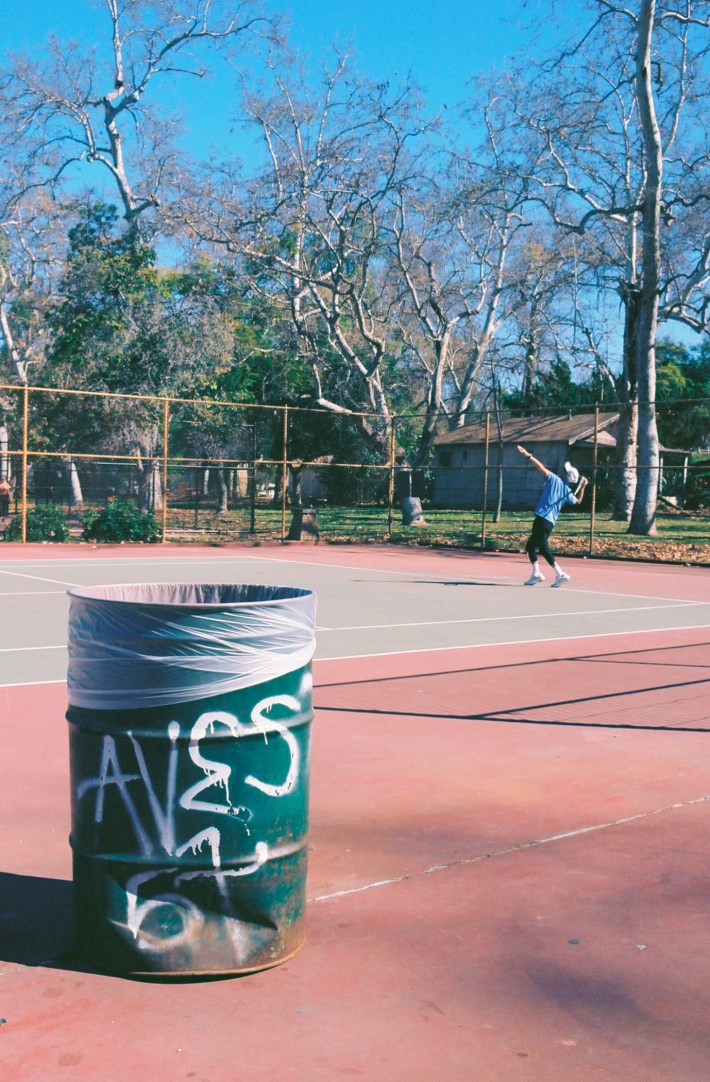
As the six-time Oscar-nominated film King Richard taught us, without the means to get trained and resources in your community, people of color need someone in their life as hardcore as Venus and Serena Williams’ father Richard to go pro in this predominantly rich, country club sport.
“This is the only sport my mom let me play as a kid,” said Art Lugo, who’s been playing at Hermon for 24 years and likes the cultural connection. He grew up in La Puente and played in high school. “We didn’t have insurance. We were pretty poor, so she said, ‘Mijo, you’re going to get hurt playing football and basketball. Tennis is safer.’”
But the lessons aren’t cheap. You can count on one hand the number of professional American Latino tennis players. There’s Ernesto Escobedo III, who grew up in West Covina and recently qualified for a tournament at Indian Wells. His father, Ernesto Jr., played pro and his aunt, Xóchitl Escobedo, was top 300 and competed in the 1988 Olympics. His cousin, Emilio Nava (son of Xóchitl) plays professionally. Sabrina Santamaria, is a half Panamanian, half Filipina pro from L.A. who, like the Williams sisters, was coached by her dad.
“I’m hitting a ball against a wall right now at a court in La Puente where my son coaches tennis,” said Cota. “He has a lot of Asian and Indian students and I see Latino kids from the area playing at the playground nearby just watching. I can tell they want to play, but their parents aren’t into tennis. I want to see more raza doing this.”
As for their long-term goals, Reyes doesn’t blink an eye. “Play and stay alive,” he said.
Cota and his crew can be found most weekend afternoons playing doubles in the lower five courts at Hermon. They prefer these to the other six because they’re built closer to the ideal north/south position, which minimizes sun exposure. The pandemic hasn’t stopped them much. They started using their rackets instead of their hands to shake after a match, sitting six feet apart, and drinking shots of tequila out of their own glass. When they got to the courts one day, though, they were locked. Reyes asked the 86-year-old doctor who was still out there playing how safe it was.
“He said, ‘You know what Guillermo, as long as you don’t touch, kiss, or hug, you’ll be okay,’” said Reyes. “So we broke the lock and started playing. The police just drove by and waved.”
They’ve been blessed with not having any coronavirus-related casualties. The omicron did take a toll during the holidays when 10 guys got the omicron strain, but they all quarantined and were fine. The club continues to be popular for its competitiveness and tight-knit vibe. One player named Joe Hernandez drives all the way from Claremont to play here even though he’s part of a club back home. Aguilera, a Cubano from New York who’s been living in L.A. for 40 years, likes the social aspect.
“At most places, you show up, play, and leave,” said Aguilera. “Here, you want to stay. We celebrate birthdays, anniversaries, divorces.”
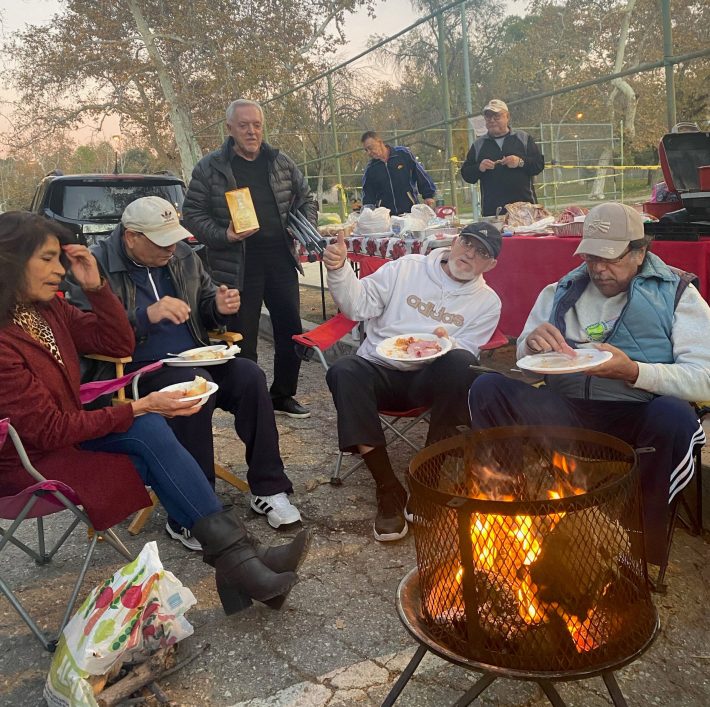
They even have memorials. Because tennis is a sport that can be played well into your 80s, it’s only natural for players to pass on. Reyes recalls about 15 players they’ve lost. The oldest players are brother-sister duo who are 88. Playing doubles slows down the speed that you have to run and the social aspect keeps the brain sharp, which can help ward off diseases like dementia and Alzheimer's. But don’t let their age fool you. They still beef on the courts.
“I’ve had to pull apart so many guys from fights,” said Reyes laughing. “Seventy-year-olds are punching each other out. There’s guys that won’t play with other guys.”
Espinoza is used to difficult personalities. A teacher for 31 years, he taught at Malabar Elementary in Boyle Heights for 17 and has been playing at Hermon for 20 years. He discovered the tennis crew while jogging around the park one day. He was 50 years old and joked that like a kid, he asked the guys if he could play with them. They said yes, but he had to bring beer. Espinoza likes the diversity of the club.
“We have professionals, people who are working class,” said Espinoza. “We have Asians, Black people.”
Players get together off the courts too, traveling to Palm Springs, where some members moved and playing at a friend’s private home court in Alhambra. They hit balls around town but always come back to their roots. They’re even more inspired to play at Hermon as the renovation is finally underway and the courts are getting a new paint job. As for their long-term goals, Reyes doesn’t blink an eye.
“Play and stay alive,” he said.
Editor’s note: L.A. TACO would like to thank L.A. TACO supporter Norma Manzanares for this story tip.
